Abstract
The scientific assessment of mariculture carbon sinks is crucial to recognize its potential as a significant component of marine blue carbon in global climate change mitigation. Therefore, the objective of the research was to estimate the seaweed and shellfish mariculture carbon sink of different varieties in various sea areas. The paper emphasized the distinction between short-term carbon sequestration in seaweed and shellfish that can be removed and long-term carbon sequestration that is deposited. Methodologically, the evaluation was based on the carbon sequestration mechanism and systematic pathways in shellfish and seaweeds. Additionally, the carbon sequestration of shellfish and seaweed aquaculture over the last decade was evaluated by the carbon sink assessment model, and the reasons for the differences in the carbon sink capacity of mariculture in China’s coastal provinces were discussed by using the LMDI decomposition model. The results indicated the carbon sequestration of offshore seaweeds and shellfish mariculture in China was huge. From 2010 to 2020, offshore seaweed aquaculture in China amounted to 7.959 Mt C/a, while shellfish aquaculture contributed 33.542 Mt C/a to the carbon sinks. Sedimentary carbon sequestration by shellfish accounted for 51% of the total carbon sequestration in mariculture involving shellfish and seaweeds. Especially noteworthy is the sedimentary carbon sequestration by shellfish, which is an indispensable and crucial component of mariculture carbon sequestration estimation. It is concluded that improvements in farming efficiency exerted the greatest influence on the variations of the mariculture carbon sink, while adjustments in farming structure had a relatively minor impact in the case of little change in aquaculture yield. Enhancing farming efficiency emerges as a practical approach to bolstering the carbon sink potential of marine aquaculture fisheries in the future.
1. Introduction
Global warming is one of the most significant environmental issues mankind is facing at present. Since the Industrial Revolution, human activities have led to the large-scale combustion of fossil fuels and the release of a large amount of CO2 into the atmosphere, which has increased the content of greenhouse gases in the atmosphere and exacerbated the global greenhouse effect [1]. At the same time, both marine ecosystems and global climate have been greatly affected [2]. China pledges to strive for a CO2 emissions peak in 2030 and strives to achieve carbon neutrality by 2060 [3] in order to cope with the global climate change issue. Achieving the dual carbon goal includes two main strategies: reducing carbon emissions and enhancing carbon sinks [3]. The oceans, which make up 71% of the earth’s surface, are the largest carbon reservoirs in the global ecosystem. It can absorb about 30% of the global CO2 emissions per year [4]. Carbon sequestration through marine ecosystems has also become a popular field of carbon sink research in recent years [5,6,7]. The carbon sink of mariculture has received widespread attention.
Fishery production activities can encourage aquatic organisms to absorb or use greenhouse gases and move the carbon out of the water column by harvesting biological products, which is called a “removable carbon sink” [8,9]. The majority of studies are based on the model of a “removable carbon sink” to measure the carbon sink [10,11]. The academic community has increasingly come to acknowledge that shellfish and seaweed mariculture have enormous carbon sink potential [12,13]. Seaweed and macroalgae are types of algae. They are multicellular photosynthetic organisms belonging to a polyphyletic group without taxonomic value. However, algae are unicellular or multicellular marine organisms. Seaweeds (=macroalgae) correspond to a polyphyletic group of multicellular photosynthetic organisms without taxonomic value. The taxa studied so far fall under the category of seaweeds [14]. Specifically, seaweeds can transform inorganic carbon in seawater into organic carbon through photosynthesis and promote organism growth. Concurrently, the partial pressure difference of carbon dioxide at the air-sea interface promotes the diffusion of atmospheric CO2 into seawater. The analysis of the global ocean revealed that seaweeds could contribute to the diffusion increment of CO2 from the atmosphere to the ocean of approximately 0.72 Gt/a if they are artificially harvested under controlled culture conditions [15]. As seaweeds are harvested, carbon can be extracted straight from seawater. Due to high biomass production and a relatively long turnover time (1 year carbon sequestration time), seaweeds can be studied as an effective carbon sink [8]. Several scholars have evaluated the carbon sink capacity of seaweeds by using the macroalgae carbon sink measurement method [16,17,18]. The total carbon sequestration of seaweeds in the Yellow Sea and Bohai Sea accounted for about 51.75% of that in China [16]. However, it is incomplete to only calculate the biomass carbon fraction. A portion of the carbon sequestration by seaweeds will be transferred to the water column or sediment in the form of DOC (Dissolved Organic Carbon) and POC (Particulate Organic Carbon) [18]. We have established that most seaweeds have a limited capacity to act as long-term carbon sinks, but they could make significant contributions to global carbon sequestration by acting as “carbon donors” [19]. Seaweed carbon is donated to other recipient habitats that have long-term sequestration, including the deep sea, mangrove forests, seagrass beds, and salt marshes [20,21]. Seaweeds can increase their productivity and sequestration capacity by ingesting and depositing carbon within habitats through shellfish [22].
The ability of filter-feeding shellfish to drive the transport and transformation of various forms of carbon is a key focus of research in this field. There are three processes for mariculture shellfish to utilize carbon in the ocean: calcification for shell formation, assimilation for soft tissue growth, and biological deposition for carbon sequestration. On the one hand, shellfish absorb dissolved inorganic carbon from seawater to generate calcium carbonate shells [23]. According to the output, mass proportion, and carbon content of shellfish, the shellfish biomass carbon sink in China from 1999 to 2008 was 860,000 t C/a, of which 670,000 tons of carbon were fixed in the form of shells [24]. Currently, the majority of scholars have come to recognize the calcification mechanism, which states that the generation of every 1 mol of calcium carbonate will release 1 mol of CO2 into seawater. The reaction formula is as follows: Ca2+ + 2HCO3− = CaCO3 + CO2↑ + H2O [24]. Despite all the ways fixed with carbon, there is still a dispute regarding whether the shellfish carbon fixation process serves as a carbon source or a carbon sink, a question that remains unresolved [25]. However, 2 mol of bicarbonate can be absorbed from seawater during the calcification process [24]. Therefore, the whole process can be regarded as a carbon sink [26]. In terms of the entire life cycle, the role of the shellfish in the ecosystem can be explained by the carbon budget. Only 30% of the CO2 is released during a shellfish growth cycle, while 30% of the CO2 is moved out of the seawater, and another 40% is sequestered in the seawater [27]. On the other hand, shellfish have a very effective filter-feeding system combined with a high filtration rate, which can synthesize their material by ingesting and assimilating. This process can promote the growth of soft tissue and fix carbon in seawater [25]. More than 97% of the carbon in the soft tissue is provided by DOC, POC, or marine sediments in seawater [28]. The mechanism of soft tissue formation and the different processing methods of soft tissue after harvest are important parameters in assessing the carbon sequestration function [24]. Shellfish increase the carbon content of the organism by filter feeding while also decreasing the carbon concentration in the water. The organic carbon, which is not utilized by shellfish, settles on the seafloor in the form of fake manure [29]. In biological deposition carbon sequestration, a small fraction of suspended particles gathered to form larger particles of metabolic substances and accelerated to settle to the seafloor. Laboratory cultures have shown that each gram of mussels by dry mass contains about 0.13 g C/a in their feces [30]. In Sango Bay, field measurement revealed that the bio-deposition carbon sequestration was over three times greater than removable carbon sequestration [27]. The significance of biological deposition was demonstrated by using the carbon budget method. During the cultivation period, an oyster used 15 g C/a in the water, with 24% of the carbon being sequestered in the shell and 2.9% promoting the growth of soft tissue. Additionally, around 22.2% of the carbon was fixed by biological sediments [27]. In general, the carbon sink function of mariculture shellfish is highly effective and significant. It is critical to clarify the varying storage times of carbon sinks. The storage cycle of carbon in mariculture is related to the way carbon is processed. During their growth, seaweeds and shellfish sequester biomass carbon, which is rapidly converted to carbon dioxide and released into the atmosphere after being processed or consumed. Therefore, it is necessary to discuss the processing and consumption of carbon footprints in the next step.
A large number of studies have discussed the carbon sequestration potential of mariculture, coastal wetlands, and offshore ecosystems [31,32]. The existing “removable mariculture carbon sink” only contains carbon biomass by harvesting shellfish and seaweed organisms. The focus of the controversy is how long this removable carbon can be stored out of the atmosphere. With the growth of seaweeds and shellfish, they absorb CO2 from the atmosphere and fix a large amount of organic carbon, such as dissolved organic carbon. The particulate organic carbon formed by biological pumps is ultimately deposited and buried on the seafloor or transported to the deep sea through direct subsidence [33], creating an effective regulation of the carbon cycle [34]. However, the transfer of POC generated by biological pumping is limited [35]. Organic carbon in seawater depends on microbiomes to form stable RDOC. The total carbon of RDOC is equivalent to the harvested carbon biomass [24]. It can be fixed for a long period and stored for tens of thousands of years [34,35,36]. The present assessment of the large amount of deposited carbon in shellfish organisms, as well as particulate organic carbon and dissolved organic carbon, has not been given much attention [18,37]. It will result in an underestimation of the carbon sink capacity of shellfish and seaweeds. Most of the dissolved organic carbon (RDOC) formed will be recalcitrant in the ocean for a long time. Additionally, in order to enhance the carbon sink capacity of mariculture shellfish and seaweeds in China, it is necessary to analyze the factors that affect them in order to provide policy measures for increasing the sinks. This paper considers the carbon sequestration of shellfish deposition and the POC and DOC released during the growth of seaweeds. It is based on the statistics of China’s fishery department and the assessment method used to estimate the carbon sink capacity of mariculture shellfish and seaweeds in China’s coastal regions from 2010 to 2020. The Logarithmic Mean Divisia Index (LMDI) method was utilized to analyze the factors influencing the carbon sink in order to realize the goal of “carbon neutrality”.
2. Materials and Methods
2.1. Construction of a Carbon Sink Accounting System for Mariculture Shellfish and Seaweeds
The total carbon sink can be divided into different categories, including mariculture seaweeds and shellfish carbon sinks (Figure 1). Within the shellfish and seaweeds category, there are various varieties of shellfish and seaweeds. Furthermore, the seaweed’s carbon sink can be further divided into biomass carbon sink, DOC, and POC. The mariculture shellfish carbon sink is divided into removable carbon sinks and sedimentary carbon sequestration. Among them, the data on output and area of different taxa were obtained from the China Fisheries Statistical Yearbook (2010–2020) [38]. The calculation method is based on the industry standard of the Marine Carbon Sink Accounting Method (HY/T 0349-2022) [39], which was approved by the Chinese Ministry of Natural Resources. In addition, the POC and DOC of mariculture seaweeds are calculated with the experience coefficient [18]. The shellfish deposition carbon sequestration is considered from the perspective of the burial rate of organic carbon. The model for shellfish deposition carbon sequestration was established by using the mariculture area and the rate of organic carbon deposition.
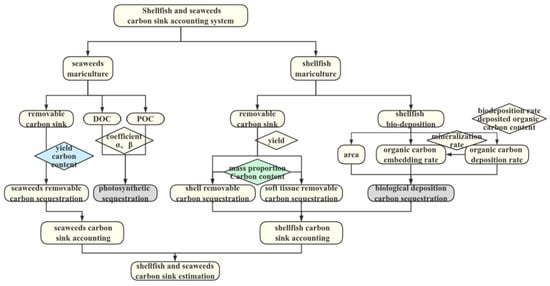
Figure 1.
Carbon sink accounting system of mariculture shellfish and seaweeds in offshore China.
2.2. The Measurement Method of Carbon Sink for Mariculture Shellfish and Seaweeds
- Removable carbon sinks of shellfish and seaweeds
The main species of mariculture seaweeds include Saccharina japonica, Undaria pinnatifida, Porphyra sensu lato, and Gracilaria ferox [24]. The output of these four species accounts for more than 95% of the total mariculture seaweed output in the country. The data on seaweeds in the fishery yearbook are measured according to dry mass [38]. The removable carbon sequestration from mariculture seaweeds can be directly calculated by the output and carbon content.
Among them, represents the biomass of carbon sinks in different mariculture seaweed species, represents the dry mass of seaweeds, and represents the seaweed carbon content under the dry mass. The required parameters are shown in Table 1.

Table 1.
The carbon content of seaweeds.
The species of mariculture shellfish mainly include Magallana gigas, Anadara broughtonii, Mytilidae, Patinopecten, Meretrix lusoria, and Sinonovacula constricta [24]; the total output of six species accounts for more than 91% of the output of mariculture shellfish in China. According to the output measurement standard of the Fishery Statistical Yearbook [38], all other aquatic products are measured according to the actual mass of fresh products, except for seaweeds [38]. When calculating the amount of shellfish carbon sequestration, the shellfish yields need to be converted to dry mass. The mariculture shellfish removable carbon sink of each species is composed of the sum of carbon sink in shells and soft tissues. The carbon sequestrated in the soft tissues, as well as the carbon sequestrated in the shell, were calculated based on the different mass proportions of the soft tissue and shell. The calculation formula is as follows:
Of which means each shellfish species’ removable carbon sink capability, refers to the soft tissue removable carbon sink, refers to the removable carbon sink of the shell, represents the output of different species, represents the conversion coefficient between wet mass and dry mass of different mariculture shellfish, and are the mass proportion of soft tissue and shell respectively, and are the carbon content of soft tissue and shell. The parameter values are shown in Table 2.

Table 2.
Mass proportion and carbon content of different taxa of shellfish tissue and shell.
- 2.
- The measurement method of photosynthetic carbon sequestration of mariculture seaweeds
The mariculture seaweed yield and carbon content are important parameters for calculating the removable carbon sink, but it cannot fully reflect its photosynthetic productivity. In fact, partial photosynthetic productivity exists in the form of dissolved organic carbon and particulate organic carbon [18]. The carbon values are calculated by using the empirical coefficients of the proportion of DOC and POC (respectively ) in photosynthetic carbon sequestration [18].
where, , , and respectively represent each seaweeds species’ biomass carbon sinks, the amount of dissolved organic carbon and particulate organic carbon, represents the photosynthetic carbon sequestration intensity by seaweeds. The empirical coefficients (a = 5%, b = 19%) are used to calculate the DOC and POC released by seaweeds [18].
- 3.
- The measurement method of biological deposition of mariculture shellfish
The shellfish bio-deposition carbon sequestration is an important part of the carbon sink in shellfish mariculture. It can eventually be buried in the seabed for thousands of years and transported to the deep sea. From the perspective of organic carbon embedment of mariculture shellfish, the carbon sequestration amount of biological sediment is calculated as follows [42]:
represents the different shellfish carbon deposition, is the different shellfish organic carbon deposition rate (mg/m2/d), is the mariculture area of shellfish, is the breeding time, and is the organic carbon embedding rate of biological sediments. The organic carbon embedding rate and the organic carbon deposition rate are two important parameters. The parameters of different shellfish can refer to the empirical formulas provided by relevant scholars [43,44]:
where represents the biological deposition rate of the different shellfish species. represents the organic carbon content in the biological sediment of the mariculture shellfish. It is determined by the different species and the size of shellfish. M is the rate of organic carbon mineralization (mg/m2/d).
The parameters have significant differences in the different sea areas, so the organic carbon content and organic carbon mineralization rate of different species and size of shellfish in the Bohai-Yellow Sea and the South China Sea areas are shown separately in Table 3. A map of China’s coastal areas is shown in Figure A1 in Appendix A.

Table 3.
Biological deposition rate, organic carbon content, and organic carbon mineralization rate of shellfish taxa of various sizes in different sea areas.
2.3. Decomposition of Influencing Factors of Mariculture Carbon Sink
After estimating the carbon sink capacity of mariculture shellfish and seaweeds in different regions, the Logarithmic Mean Divisia Index (LMDI) was used to further analyze the influencing factors of the carbon sink capacity of marine aquaculture. This analysis allowed for a discussion on the change trends of the carbon sink over time. LMDI is an analytical factor decomposition method proposed by Ang et al. [47]. It has been widely used in the decomposition of carbon emission factors. Currently, it is extensively utilized in various fields, including energy and carbon sinks in marine aquaculture [48,49]. The specific operation of decomposing influencing factors is as follows: the influencing factors of carbon sink are categorized into the carbon sink coefficient (CSC), structural factor (STF), efficiency factor (EFF), and scale factor (SCF) by using the LMDI decomposition model. The relationship between them is as follows:
where variant i represents different species. The first item is the carbon sink coefficient factor, which represents the proportion of the carbon sink of mariculture species in its output and is used to measure the conversion of the carbon sink. The second item is the proportion of species i in the total seaweeds and shellfish mariculture, and it reflects the structural effect of carbon sinks. The third item is the output of shellfish and seaweeds in the unit area of marine aquaculture, which reflects the mariculture efficiency level of shellfish and seaweeds. The fourth item is the mariculture area, indicating the scale effect of seaweed and shellfish mariculture.
Because the carbon sink coefficients of each taxon in different periods are constant, the contribution value of the carbon sink coefficient is always zero, and the carbon sink coefficient is not discussed. Using the LMDI decomposition model under the same external environmental conditions, a connection is established between the impact of structure factor, efficiency factor, and scale factor on carbon sinks. Each item represents the contribution value of the influencing factor to the total carbon sink change. When the contribution is greater than zero, it represents a positive contribution, and when the contribution is less than zero, it is a negative contribution.
In Equations (13)–(15), , , and respectively represent the contribution values of the structural factor, efficiency factor, and scale factor to the transformation of carbon sink capacity. T is the time interval, and 0 is the data for the base period. The chosen time in this paper is one year. This means that the contribution of the three influencing factors of mariculture drives changes in the carbon sink capacity compared with the previous year.
3. Results
3.1. Estimation of Removable Carbon Sink of Shellfish and Seaweeds in China
There is a notable disparity in the overall carbon sink capacity of shellfish and seaweeds in China’s coastal provinces during 2010–2020. More than 5 million tons of cumulative removable carbon were sequestered by shellfish and seaweeds in Shandong and Fujian provinces from 2010 to 2020. Additionally, in Liaoning and Guangdong provinces, the total biomass of carbon sink has surpassed 2 million tons. Owing to the limited number of species and the poor mariculture yield, Hainan Province has the lowest carbon sequestration. With the exception of Fujian Province, shellfish have a significantly greater capacity to sequester carbon compared to seaweeds in coastal provinces. Shellfish mariculture carbon sink made up the majority of the total carbon sink of shellfish and seaweeds. Shandong Province had the largest shellfish carbon sequestration capacity, about 3.75 million tons, whereas Fujian Province had the largest seaweed carbon sequestration capacity, about 2.76 million tons.
Figure 2 shows the huge difference in the removable carbon sink among different provinces. The major provinces that are involved in marine aquaculture include Liaoning, Shandong, and Fujian. Due to the differences in the yield and structure, the carbon sink of each mariculture species is also different. The carbon sink of various species of shellfish and seaweeds is further explored in the following section.
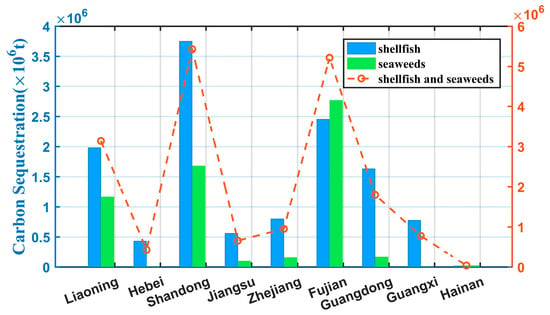
Figure 2.
The removable carbon sink of mariculture shellfish and seaweeds in each province (The left axis scale concerns either shellfish or seaweeds, while the right axis scale applies to both shellfish and seaweeds).
The carbon sink capacity of Patinopecten and Meretrix lusoria accounted for more than half of the total carbon sink of shellfish in the northern provinces of Liaoning, Hebei, and Shandong. Additionally, the carbon sink capacity of Magallana gigas and Meretrix lusoria dominated the carbon sink capacity of shellfish in the southern province (Figure 3a). The removable carbon sink of shellfish in the Liaoning, Hebei, and Shandong provinces slightly decreased from 2017 to 2019. In the southern provinces of Fujian, Guangdong, and Guangxi, Magallana gigas contributed more than 60% of the carbon sequestration. The carbon sink decreased slightly after 2017 in Guangdong Province, from 161,399 tons in 2016 to 152,826 tons in 2017. Except for Guangdong and Hainan, the amount of carbon sinking in other southern provinces increased year by year. Overall, the carbon sink capacity of shellfish exhibited an increasing trend from 2010 to 2020. In comparison, Jiangsu Province has a relatively lower overall output and a weaker carbon sequestration capacity. The amount of carbon sequestration fluctuates around 50,000 tons, which is an insignificant trend in Jiangsu. Its annual average carbon sequestration is equivalent to that of about 15% of Shandong Province. The contribution of Magallana gigas and Mytilidae is increasing year by year in Zhejiang Province. The primary species responsible for this increase is the Sinonovacula constricta, which accounts for 37.4% of the annual average carbon sequestered. However, this proportion has been decreasing from 2014 to 2020, dropping to 32.38% in 2020. Hainan province is dominated by the mariculture Meretrix lusoria. However, the overall marine aquaculture capacity is weak, and the majority of its marine pastures are conservation-type, which is not suitable for the development of shellfish and seaweeds. Especially after 2018, when a free trade port was built to encourage the growth of recreational fisheries [50,51], the carbon sink of shellfish in Hainan Province was reduced to fewer than 1000 t/a.
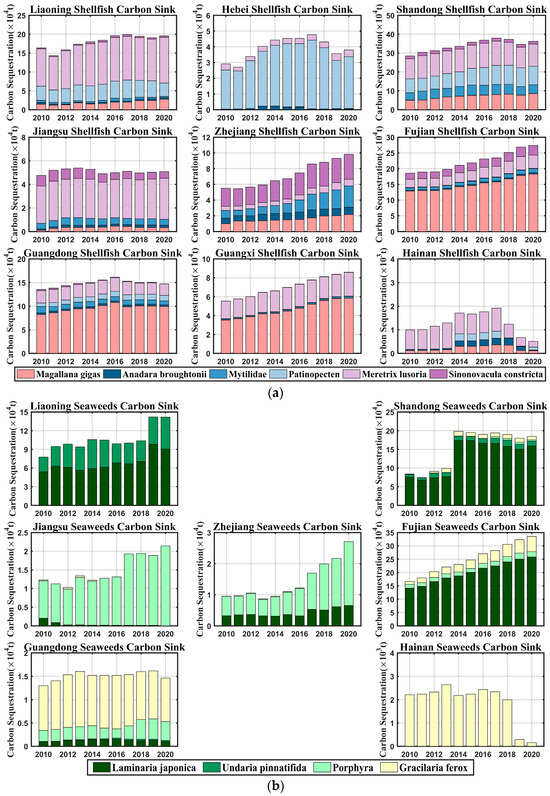
Figure 3.
(a) Removable carbon sink of different taxa of shellfish in different provinces; (b) Removable carbon sink of different taxa of seaweeds in different provinces.
Based on the data from the China Fishery Statistical Yearbook, it is noted that the seaweed production in Hebei and Guangxi provinces is relatively low. The carbon sink of seaweeds in each province is illustrated in Figure 3b. The principal species of seaweed in Liaoning, Shandong, and Fujian provinces is kelp (Saccharina japonica), which has the largest carbon sink capacity. In addition to kelp (Saccharina japonica) mariculture, Liaoning province also has significant carbon sequestration from wakame (Undaria pinnatifida). The years in which carbon sequestration increased by seaweeds from different provinces varied dramatically. Liaoning had the most significant increase in 2019, with a growth rate of 37% compared to the seaweed removable carbon sequestration in 2018. The greatest increase in seaweed carbon sequestration in Shandong province occurred in 2014, which was twice as high as in 2013. In contrast, there was a slight decrease in sequestration in the provinces of Jiangsu and Zhejiang during the first five years. The fastest growth rate was recorded in 2017. From 2010 to 2020, the carbon sequestration of seaweeds in Fujian Province has shown consistent growth, with an increase of about 17,000 t/a. The overall carbon sequestration by seaweeds in Guangdong and Hainan was relatively weak. Guangdong sequestered approximately 15,000 t C/a, while Hainan only sequestered 2000 t C/a. While both shellfish and seaweeds have a strong ability to fix carbon, the fixed carbon in seaweeds and shellfish soft tissue will return to the atmosphere after being consumed by humans. It is important to note that only shell carbon sequestration belongs to long-term carbon sequestration. Similar to coastal wetland carbon sinks and offshore ecosystem carbon sinks, biomass carbon sinks in mangroves, seagrass beds, and lagoons belong to short-term carbon sinks [6,52,53]. Therefore, long-term sequestration of sediment, POC, and RDOC is considered in the future.
3.2. Estimation of Photosynthetic Carbon Sequestration Intensity of Mariculture Seaweed
The assessment of removable carbon sinks in mariculture seaweeds only takes into account the carbon content of the seaweeds. However, the photosynthetic carbon sequestration intensity cannot be fully assessed by the yield of seaweeds and their carbon content. The biomass of seaweeds cannot adequately describe their photosynthetic activity, as certain products of photosynthesis will migrate into sediment or water bodies through intricate biochemical processes. The biomass carbon sink of seaweed is a short-term sink. The long-term carbon sinks of POC that are buried in the seafloor and DOC that are transported to the deep ocean cannot be ignored. The estimated results of the photosynthetic carbon sequestration of seaweeds are shown in Figure 4. By 2020, the photosynthetic carbon sequestration of mariculture seaweeds in China’s coastal region is expected to reach 954,600 tons. In addition to removable carbon by harvesting seaweeds, 47,700 tons of carbon have entered water and sediment in the form of DOC, while approximately 181,400 tons of POC have entered the water column and sediments through debris and deposition.
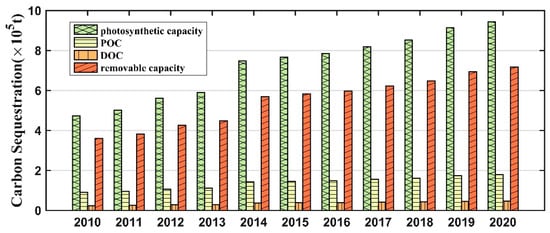
Figure 4.
Photosynthetic carbon sequestration of mariculture seaweeds from 2010 to 2020.
3.3. Estimation of Carbon Sequestration by Shellfish Deposition
In terms of the changing trend of carbon sinks for shellfish and seaweeds, the carbon sink from mariculture shellfish and seaweeds in China has steadily increased from 2010 to 2020 (Figure 5). In 2020, the removable carbon sink of mariculture shellfish and seaweeds in nine coastal provinces reached 1.97 million tons. There was a 49.4% increase in the removable carbon sink of mariculture shellfish and seaweeds in 2010 compared to previous years. This upward trend continued from 2010 to 2015. The average annual growth rate of the removable carbon sink of mariculture shellfish and seaweeds was 5.6% from 2010 to 2015. After 2015, the growth rate of removable carbon sinks slowed down, and the average annual growth rate decreased to 2.6%.
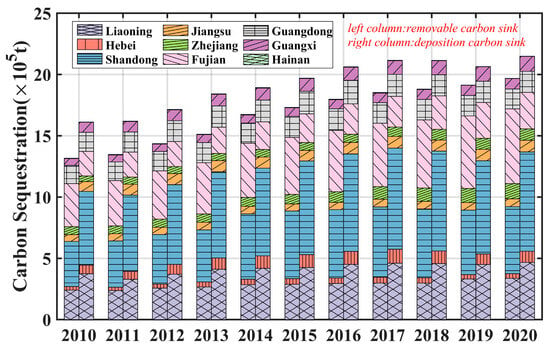
Figure 5.
Carbon sequestration of mariculture shellfish in China during 2010–2020.
However, during the growth of shellfish, large amounts of carbon can be deposited and buried in seabed or transported to the deep ocean. These contributions are often neglected and excluded from mariculture carbon sinks. Bio-deposition is the process of aggregating small particles of suspended matter to form larger particles of metabolic matter through filter feeding. It will bury the carbon in the seafloor for thousands of years, which can contribute significantly to the carbon sink function of mariculture shellfish.
The excretion of particulate matter generated by the metabolism of bivalves’ shellfish, which have a strong filtration capacity, contributes significantly to biological deposition. Existing literature studies have primarily focused on the Magallana gigas, Patinopecten, and Meretrix lusoria. It can be seen in Figure 3a that mariculture shellfish are primarily based on filter-feeding bivalve species. Liaoning, Hebei, Shandong, Jiangsu, and Zhejiang utilized data from Bohai and the Yellow Sea, while Fujian, Guangdong, Guangxi, and Hainan Provinces utilized data from the South China Sea. The carbon sequestration of shellfish deposition demonstrated an upward trend from 2010 to 2017 (Figure 5). However, the quantity of carbon sequestered by shellfish deposition decreased from 2017 to 2019, and it remained essentially constant at 2.15 million tons in 2020. A comparison of the shellfish deposition carbon sequestration in Liaoning and Shandong revealed that these regions accounted for over 60% of the total carbon sequestration from mariculture shellfish deposition. The sedimentary carbon sequestration of mariculture shellfish in Liaoning and Shandong reached 4.62 million tons and 8.07 million tons, accounting for 21.8% and 38.1%, respectively.
The carbon sequestration of shellfish deposition from 2010 to 2020 is shown in Figure 6. Meretrix lusoria dominated the deposition of carbon sequestration in the north province, while Magallana gigas dominated the deposition of carbon sequestration in the south province. Shandong Province boasts the highest carbon sequestration through biological deposition, with a deposition carbon sequestration amount of 732,000 t C/a. Liaoning Province follows with a biological deposition carbon sequestration of 420,000 t C/a, while Fujian Province has approximately 240,000 t C/a of biological deposition carbon sequestration. Guangdong and Guangxi sequestered around 100,000 t C/a of carbon.
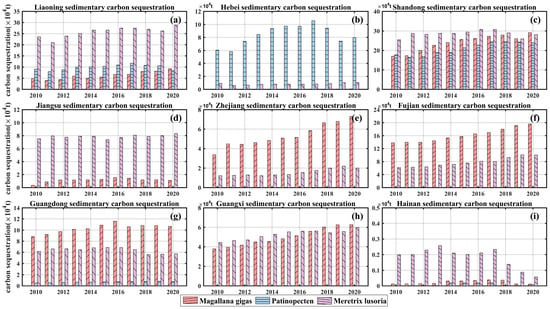
Figure 6.
Sedimentary carbon sequestration of different species of shellfish in different provinces. (a–i) represent different provinces.
In addition, the deposition carbon sequestration capacity of Meretrix lusoria in the Bohai and Yellow Seas and the Magallana gigas in the South China Sea is more significant. It can be concluded that the difference in carbon sequestration is the result of the variation in the organic carbon deposition rate between the two seas. It shows the trend of carbon sequestration from 2010 to 2020 after taking into account removable carbon sinks and shellfish bio-deposition (Figure 7a), which is consistent with the trend of shellfish bio-deposition. This situation illustrates the important role of shellfish bio-deposition. The carbon sequestration from 2018 to 2019 decreased by 463,000 tons. Figure 7b shows the total carbon sequestration and the average annual growth rate of each province in 2010 and 2020. It is discovered that the changes in carbon sequestration differ significantly in each province. The carbon sequestration capacity of Shandong and Fujian Province has changed by more than 350,000 tons, while that of Hebei and Jiangsu Province has changed by only 25,000 tons. In Zhejiang Province, the highest average annual growth rate is about 7%, with its carbon sequestration capacity increasing by 107,000 tons from 2010 to 2020. Apart from Hainan Province, where the average annual growth rate of carbon sequestration was −12.2%, all other provinces had growth rates of less than 10%.
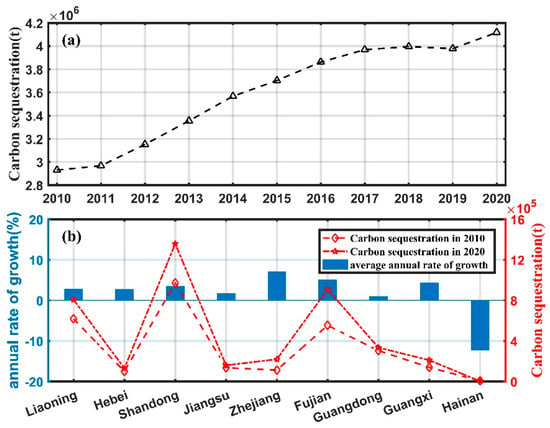
Figure 7.
(a) Total carbon sequestration of mariculture shellfish and seaweeds in China from 2010 to 2020; (b) Total carbon sequestration in 2010 and 2020 and average yearly growth rate of each province.
4. Discussion
4.1. Mariculture Carbon Sink Capacity
The biomass carbon sinks of each species in offshore provinces during 2010–2020 were calculated. A comparison of the evaluation results in the literature from 2010 to 2017 [54] led to the conclusion that the calculation results in this paper are consistent with the results in the literature (Figure 8). Therefore, the calculation results presented in this paper can be utilized to evaluate the carbon sink and conduct further analysis.
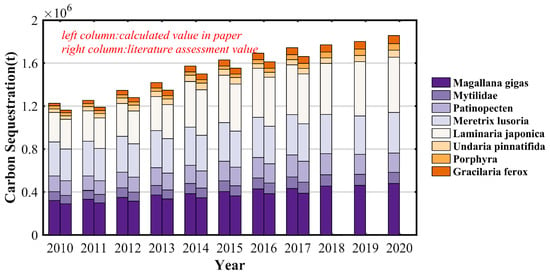
Figure 8.
Verification of biomass carbon sequestration in different mariculture species.
The distinctions between shellfish removable carbon sequestration and deposited carbon sequestration are depicted in Figure 9. The proportion of deposited carbon sequestration is below 50% only in Zhejiang Province. Sedimentary carbon sequestration in Hebei Province has the strongest effect on the total carbon sequestration of mariculture shellfish, with a removable carbon sink of about 39,000 t C/a and sedimentary carbon sequestration of 92,000 t C/a. Ignoring shellfish deposition results in an approximate 70.2% underestimate of the carbon sequestration by shellfish in Hebei. Among the provinces, Shandong Province has the highest deposition carbon sequestration, followed by Liaoning Province, with the deposition carbon sequestration of 730,000 t C/a and 420,000 t C/a, respectively. According to the revised model of mariculture carbon sequestration, it is estimated that, on average, shellfish bio-deposition accounts for approximately 51% of the total quantity of carbon sequestered. Compared with the classic “removable carbon sink” model, the mariculture shellfish carbon sequestration will be underestimated by about 63.1% without considering the shellfish sedimentary carbon sequestration.
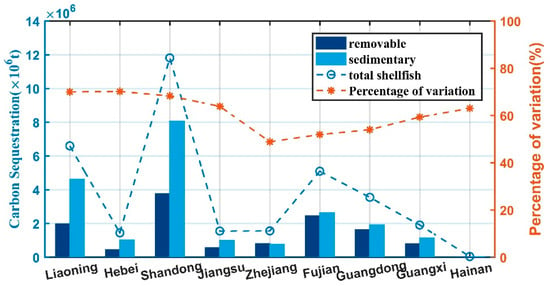
Figure 9.
Removable carbon sink and sedimentary carbon sequestration of shellfish in coastal provinces.
Besides shellfish sedimentation, POC, and mariculture DOC, seaweeds also play a significant role. The carbon sink of mariculture shellfish and seaweeds would be underestimated by 4.8% if POC and DOC sequestration were not taken into account. The seaweed culture scale in Fujian Province is the largest, with POC and DOC sequestration accounting for 9.9% of the total carbon sequestration. Additionally, POC and DOC sequestration accounted for more than 3% of the Liaoning, Shandong, and Zhejiang provinces (Figure 10). It is necessary to incorporate shellfish deposition carbon sequestration and the POC, and DOC formed in the process of seaweed growth into the evaluation model to estimate the carbon sequestration capacity of marine aquaculture.

Figure 10.
The proportion of each carbon sequestration component in the total carbon sequestration of shellfish and seaweeds.
4.2. Influencing Factor of Mariculture Carbon Sink
Further analysis of the specific development of mariculture in nine coastal provinces of China from 2010 to 2020 reveals that the carbon sink capacity of these organisms in coastal regions varies significantly. Therefore, it is necessary to explore the influencing factors that lead to the discrepancy in carbon sequestration. Based on the LMDI decomposition model, the carbon sequestration capacity was jointly influenced by the marine aquaculture structure, marine aquaculture efficiency, and marine aquaculture scale.
The variation curve of the contribution of each influencing factor to the carbon sink in different years is shown in Figure 11a. It is evident that the structural factor only slightly impacts the increase in carbon sink. The structure of the mariculture shellfish and seaweeds changes little or even remains unchanged in the two adjacent years. The contribution of mariculture efficiency to the growth of the carbon sink is the largest, particularly in 2015–2016 and 2019–2020. The efficiency factors have a major impact on the increase of the carbon sink. In two adjacent years, efficiency factors have made a positive contribution, so the change in carbon sequestration has been positive. It indicated that the influence factor of shellfish and seaweeds had played a positive role in promoting the removable carbon sink. Only in 2018–2019 did total contribution played a negative role in the change in carbon sequestration. It drove a decrease of 463,000 tons in carbon sequestration (Figure 7a). The efficiency factor plays a leading role in the carbon sink capacity of mariculture in China, while the scale factor plays a minor role. The scale factor and efficiency factor are positive in 2011–2012, 2012–2013, and 2013–2014, meaning that these three years’ total contribution is larger. Corresponding to Figure 7a, the increment in carbon sequestration in these three years is larger than in other years.
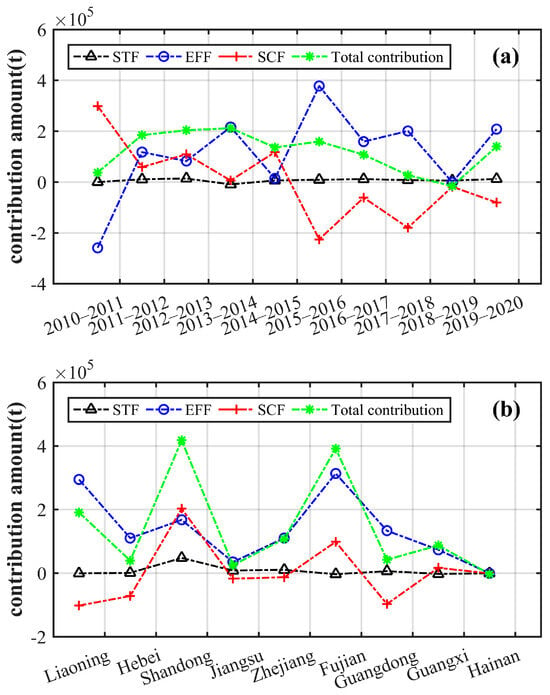
Figure 11.
(a) Contribution of the influencing factor to the change in the carbon sink over time; (b) Contribution of the influencing factor to the change in the carbon sink in the spatial dimension (STF represents structure factor, EFF represents efficiency factor, SCF represents scale factor).
In considering carbon sequestration from the perspective of different provinces, it is evident that each influencing factor’s contribution varies as well. The discrepancy in the contribution of each factor reflects the spatial heterogeneity (Figure 11b). Compared to efficiency factors and scale factors, the mariculture structure had a minimal impact on carbon sequestration in each province. It is indicated that the adjustment of the mariculture structure is not significant in each province. In the Hainan Province, carbon sequestration declined by 3060 t between 2010 and 2020 due to negative contributions to efficiency, scale, and structure factors. The mariculture efficiency contributed positively to the changes in carbon sequestration in all provinces except for the Hainan Province. The trend of carbon sequestration amount was basically consistent with the trend of efficiency factor, which was the main controlling factor. The total contributions of three factors coincided with the growth of the total carbon sequestration capacity from 2010 to 2020 (Figure 7b). As a result of the contributions to the efficiency factor and scale factor, there has been a noticeable increase in carbon sequestration in Shandong Province and Fujian Province. With a rise in carbon sequestration of 417,900 tons, Shandong Province contributed the most to the shift in carbon sequestration, causing an average annual increase in carbon sink of 3.4%.
The structural factor in Shandong Province has a great influence on the change in carbon sink. In order to explore the impact of structural adjustment in Shandong Province, taxa will discuss the carbon sequestration capacity. The carbon sink conversion of each taxon is shown in Table 4. The carbon sink conversion ratio indicates the amount of carbon that can be sequestered in 1 ton of mariculture species. It is not only an important basis on which to measure carbon sink capacity but also an embodiment of the sustainability of the mariculture carbon sink industry. The carbon sink conversion ratio of different species can provide policy support for the structural adjustment of mariculture shellfish and seaweeds. Among them, the conversion ratios of Patinopecten and Meretrix lusoria are 0.341 and 0.305, respectively, while that of the Anadara broughtonii was only 0.063. The adjustment from species with smaller carbon sink conversion to the stronger carbon sink conversion species can drive the increase in carbon sink capacity.

Table 4.
Carbon sink conversion ratio of different species.
Shandong province showed a significant positive contribution compared to other provinces by focusing solely on the structural factor. It is indicated that structural adjustment drove the growth of the carbon sink capacity of shellfish and seaweeds in Shandong from 2010 to 2020. Structural factors reflected the ratio of the output of a certain breed to the total output of mariculture shellfish and seaweeds, which mainly reflects the proportion of mariculture species. According to Table 4, the structural adjustment in Shandong Province tends to develop species with a larger carbon sink conversion ratio, making a positive contribution to the carbon sink.
5. Enhancing Effectively the China’s Mariculture Carbon Sink
By analyzing the contribution of influencing factors (e.g., Section 4.2) using the LMDI method, it is possible to enhance removable carbon sink capacity by adjusting the mariculture structure. However, in order to enhance the effect of carbon sinks, it is important to clarify the formation process of carbon sinks and distinguish between short-term carbon sequestration during the growth of seaweeds and shellfish and long-term sequestration in sediments, especially for carbon sinks with different pathways and storage times. In addition to the carbon sequestration benefit directly in the process of mariculture, marine products, after harvesting, can reduce CO2 emissions in other ways [55]. To scientifically consider the carbon sink effect of mariculture, we need to introduce carbon footprint to analyze the life cycle of shellfish and seaweed products. For example, seaweeds are used as food and bait through industrial processing, and shellfish can be processed for human use. After leaving the mariculture environment, it is easy to find that the carbon fixed in mariculture products will soon return to the atmosphere. Carbon emissions during processing and use are part of the carbon footprint. Therefore, the low-carbon intensity products can be used to replace high-carbon-intensity products or utilize the low-carbon biomass energy [4].
6. Conclusions
Mariculture is an important way to increase the current carbon sink. It is crucial to comprehensively estimate the carbon sequestration capacity of mariculture shellfish and seaweeds with the goal of achieving carbon neutrality. The study of the organic carbon pool in mariculture areas is particularly important when exploring the “missing carbon sink” in the ocean. This paper considered the role of sediment sequestration in shellfish and estimated the capacity of mariculture carbon sinks in nine coastal provinces of China.
- The removal of carbon sinks from shellfish and seaweeds shows an overall upward trend in 2010–2020, with a growth rate of more than 49%. Shandong and Fujian Provinces have the largest removable carbon sinks of shellfish and seaweeds, with a carbon sink of 500,000 t C/a. The Magallana gigas, Meretrix lusoria, and Patinopecten are known for their strong removable carbon sink capacity in marine ecosystems. Similarly, kelp (Saccharina japonica) among seaweeds also exhibits a strong removable carbon sink capacity.
- The sedimentary carbon sequestration from shellfish accounted for approximately 51% of the total carbon sink of shellfish and seaweeds in China, which is a non-negligible component of the mariculture carbon sink. The deposition of carbon from shellfish showed a trend of increasing and then decreasing from 2010 to 2020. The sedimentary carbon sequestration capacity in Shandong Province is the highest, reaching more than 730,000 t C/a. Failure to consider shellfish deposition carbon sequestration could lead to a significant underestimation of the mariculture carbon sink in Liaoning and Hebei Province.
- The mariculture efficiency has a significant influence on the change in carbon sink in each province, mainly making a positive contribution. The efficiency and scale of marine aquaculture exhibit contrasting trends. The overall scale factor shows a downward trend, while the overall efficiency factor shows an upward trend. This is likely due to the fact that different species have different carbon sink conversion ratios. Most seaweeds had a higher carbon sink conversion ratio than shellfish. The mariculture structure was adjusted from shellfish to seaweeds, which effectively increased the carbon sink.
Based on the realization that mariculture shellfish and seaweeds are stable “removable carbon sinks” and the carbon sink formation process. An in-depth study of the carbon sink capacity and the factors that influence it can help formulate a scientific and reasonable strategy for blue carbon. Currently, in addition to the removable carbon sink, the DOC and POC released by seaweeds and the quantitative assessment of RDOC have become important considerations for future mariculture carbon sinks. With the advancement of measurement methods in this field, future research should aim to fully reveal the carbon cycle process of mariculture shellfish and seaweeds. Additionally, it is important to establish a scientifically complete assessment system for carbon sinks. It is crucial to recognize that optimizing the carbon sink mode can contribute to the promotion of sustainable development in offshore aquaculture and the enhancement of marine carbon sinks.
Author Contributions
Conceptualization, S.G.; Methodology, S.G.; Validation, S.G.; Formal analysis, S.G.; Writing—original draft, S.G.; Writing—review & editing, H.N. All authors have read and agreed to the published version of the manuscript.
Funding
This study was supported by the National Natural Science Foundation of China (42141020) and the National Key Research and Development Program of China (2023YFC3107702).
Institutional Review Board Statement
Not applicable.
Informed Consent Statement
Not applicable.
Data Availability Statement
The original datasets (mariculture output and area) presented in this study are available at https://www.zgtjnj.org/navibooklist (accessed on 10 January 2024). The other data presented in this study are included in the article; further inquiries can be directed to the corresponding author.
Acknowledgments
We acknowledge the support of the National Natural Science Foundation of China and the National Key Research and Development Program of China.
Conflicts of Interest
The authors declare no conflicts of interest.
Appendix A
As shown in Figure A1 in Appendix A, China’s nine coastal provinces have a wide latitude span. China’s coast includes four seas: the Bohai Sea, the Yellow Sea, the East China Sea, and the South China Sea. Of these, Liaoning province, Hebei province, and the northern part of Shandong province are close to the Bohai Sea. The southern part of the Shandong Peninsula and the coast of Jiangsu province are bordered by the Yellow Sea. The western provinces of the East China Sea include Zhejiang and Fujian Provinces. For the South China Sea, the main bordering provinces include Guangdong Province, Guangxi Province, and Hainan Province. The differences in climate and environment are obvious in the nine provinces. Therefore, the article evaluates the carbon sink capacity of nine provinces along the Chinese coast, respectively (Figure A1 shows the nine provinces that correspond to the four sea areas).
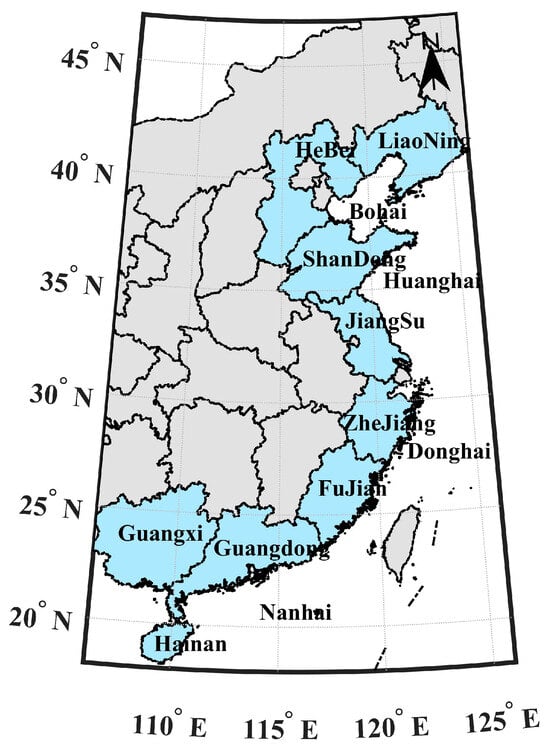
Figure A1.
Map of China’s coastal areas. The mariculture of shellfish and seaweeds in Hong Kong, Macao, Taiwan Province, Shanghai, and Tianjin was not included due to concerns about data availability and validity.
References
- Rodhe, H. A comparison of the contribution of various gases to the greenhouse effect. Science 1990, 248, 1217–1219. [Google Scholar] [CrossRef] [PubMed]
- Li, H.; Chen, T.; Zhang, H.; Yao, Z.; Ye, Y.; Xia, M. Assessment of the contribution of shellfish culture to the marine carbon cycle in China. Mar. Sci. 2014, 38, 39–45.1. [Google Scholar]
- Jiao, N. Research and development of Marine “negative emission” technology to support national “carbon neutrality” demand. Proc. Chin. Acad. Sci. 2021, 36, 179–187. [Google Scholar]
- Archer, B.D. The Global Carbon Cycle. Carbon Dioxide Clim. Soc. 1978, 241, 35–38. [Google Scholar]
- Zhang, J.; Liu, J.; Zhang, Y.; Li, G. Approach to negative marine emissions in mariculture. Proc. Chin. Acad. Sci. 2021, 36, 252–258. [Google Scholar]
- Cuellar-Martinez, T.; Ruiz-Fernández, A.C.; Sanchez-Cabeza, J.-A.; Pérez-Bernal, L.; López-Mendoza, P.G.; Carnero-Bravo, V.; Agraz-Hernández, C.M.; van Tussenbroek, B.I.; Sandoval-Gil, J.; Cardoso-Mohedano, J.G.; et al. Temporal records of organic carbon stocks and burial rates in Mexican blue carbon coastal ecosystems throughout the Anthropocene. Glob. Planet. Chang. 2020, 192, 103215. [Google Scholar] [CrossRef]
- Monnier, B.; Pergent, G.; Mateo, M.; Clabaut, P.; Pergent-Martini, C. Quantification of blue carbon stocks associated with Posidonia oceanica seagrass meadows in Corsica (NW Mediterranean). Sci. Total Environ. 2022, 838, 155864. [Google Scholar] [CrossRef] [PubMed]
- Tang, Q.; Zhang, J.; Fang, J. Shellfish and seaweed mariculture increase atmospheric CO2 absorption in coastal ecosystems. Mar. Ecol. Prog. Ser. 2011, 424, 97–105. [Google Scholar] [CrossRef]
- Tang, Q.; Jiang, Z.; Mao, Y. Carbon sink in fishery and definition of carbon sink fishery and analysis of related issues. Adv. Fish. Sci. 2022, 43, 1–7. [Google Scholar]
- Yu, Z.; Xie, X.; Zhu, S.; Du, S.; Li, X.; Li, D.; Zhou, Z.C.; Wang, Q.Z. Potential assessment of carbon sink capacity by bivalves and seaweeds in mariculture in Liaoning Province. J. Dalian Ocean Univ. 2020, 35, 382–386. [Google Scholar]
- Zhang, M.; Yan, J.; Ye, W.; Zhang, C.; Gao, Z.; Xu, C.; Li, Y.; Zhang, J.; Zhao, S.; Sun, H.; et al. Carbon sink and its potential assessment in shellfish and seaweed culture in Fujian Province. J. Appl. Oceanogr. 2022, 41, 53–59. [Google Scholar]
- Ortega, A.; Geraldi, N.R.; Alam, I.; Kamau, A.A.; Acinas, S.G.; Logares, R.; Gasol, J.M.; Massana, R.; Krause-Jensen, D.; Duarte, C.M. Important contribution of macroalgae to oceanic carbon sequestration. Nat. Geosci. 2019, 12, 748–754. [Google Scholar] [CrossRef]
- Sui, Y.; Chen, X.; Li, S.; Sun, D.; Ma, X.; Zhou, T. Spatial-temporal change of coastal blue carbon and its service value evaluation: A case study of Jiaozhou Bay. Resour. Sci. 2019, 41, 2119–2130. [Google Scholar]
- Boudouresque, C.F.; Caumette, P.; Bertrand, J.C.; Normand, P.; Sime-Ngando, T. Systematic and evolution of microorganisms: General concepts. In Environmental Microbiology: Fundamentals and Applications. Microbial Ecology; Bertrand, J.C., Caumette, P., Lebaron, P., Matheron, R., Normand, P., Sime-Ngando, T., Eds.; Springe: Berlin/Heidelberg, Germany, 2015; pp. 107–144. [Google Scholar]
- Li, C.; Qi, Z.; Huang, H.; Liu, Y.; Kong, X.; Xiao, Y. Progress of Ocean Carbon Sink Research and Discussion on the Development Direction of Carbon Sink Fisheries in the South China Sea. South. Coast Fish. 2010, 6, 81–86. [Google Scholar]
- Cao, W.; Xiao, L.; Wang, D.; Hou, J. Spatial and temporal distribution of seaweeds cultivation scale and carbon sequestration intensity in the Bohai-Yellow Sea. Mar. Sci. 2018, 42, 112–119. [Google Scholar]
- Shao, G.; Liu, B.; Li, C. Assessment of carbon sequestration capacity of mariculture in major sea areas in China and its impact effect: Based on panel data from nine coastal provinces in China. J. Ecol. 2019, 39, 2614–2625. [Google Scholar]
- Yan, L.; Huang, H.; Chen, J.; Yang, X. Estimation of carbon sink intensity in offshore seaweeds aquaculture in China. Adv. Mar. Sci. 2011, 29, 537–545. [Google Scholar]
- Hill, R.; Bellgrove, A.; Macreadie, P.I.; Petrou, K.; Beardall, J.; Steven, A.; Ralph, P.J. Can macroalgae contribute to blue carbon? An Australian perspective. Limnol. Oceanogr. 2015, 60, 1689–1706. [Google Scholar] [CrossRef]
- Wada, S.; Aoki, M.; Mikami, A.; Komatsu, T.; Tsuchiya, Y.; Sato, T.; Shinagawa, H.; Hama, T. Bioavailability of macroalgal dissolved organic matter in seawater. Mar. Ecol. Prog. Ser. 2008, 370, 33–44. [Google Scholar] [CrossRef]
- Macreadie, P.I.; Allen, K.; Kelaher, B.P.; Ralph, P.J.; Skilbeck, C.G. Paleoreconstruction of estuarine sediments reveal human-induced weakening of coastal carbon sinks. Glob. Chang. Biol. 2012, 18, 891–901. [Google Scholar] [CrossRef]
- Hyndes, G.A.; Nagelkerken, I.; McLeod, R.J.; Connolly, R.M.; Lavery, P.S.; Vanderklift, M.A. Mechanisms and ecological role of carbon transfer within coastal seascapes. Biol. Rev. 2014, 89, 232–254. [Google Scholar] [CrossRef] [PubMed]
- Jiang, X.; Li, L.; Dong, S. Application of a new model for quantifying CO2 release in shellfish culture areas. Chin. Aquat. Sci. 2022, 29, 1693–1703. [Google Scholar]
- Zhang, Y.; Zhang, J.; Liang, Y.; Li, H.; Li, G.; Chen, X.; Zhao, P.; Jiang, Z.; Zou, D.; Liu, X. Formation process and mechanism of carbon sink in offshore aquaculture environment in China. Sci. China Earth Sci. 2017, 47, 1414–1424. [Google Scholar]
- Jiang, Z.; Fang, J.; Mao, Y.; Jiang, W.; Fang, J.; Lin, F.; Gao, Y.; Du, M.; Li, R. Research progress on the carbon sink function in filter-feeding shellfish culture and future scientific issues of concern. Adv. Fish. Sci. 2022, 43, 106114. [Google Scholar]
- Liu, H.; Tang, Q. Research progress of international marine biological carbon sinks. Chin. Aquat. Sci. 2011, 18, 695–702. [Google Scholar]
- Ren, L. Raft Culture of Long Oysters and Its Main Filter-Feeding Attached Organisms’ Carbon Sequestration in Sango Bay. Ph.D. Thesis, Graduate University of Chinese Academy of Sciences (Institute of Oceanography), Beijing, China, 2014. [Google Scholar]
- Quan, W.; Ying, M.; Zhou, Q.; Xu, C. Carbon source analysis of cultured shellfish based on stable carbon isotope technology. J. Shanghai Ocean Univ. 2018, 27, 175–180. [Google Scholar]
- Crawford, C.M.; Macleod, C.K.; Mitchell, I.M. Effects of shellfish farming on the benthic environment. Aquaculture 2003, 224, 117–140. [Google Scholar] [CrossRef]
- Rodhouse, P.G.; Roden, C.M.; Hensey, M.P.; Ryan, T.H. Resource allocation in Mytilus edulis on the shore and in suspended culture. Mar. Biol. 1984, 84, 27–34. [Google Scholar] [CrossRef]
- Moreira, D.; Pires, J.C. Atmospheric CO2 capture by algae: Negative carbon dioxide emission path. Bioresour. Technol. 2016, 215, 371–379. [Google Scholar] [CrossRef]
- Macreadie, P.I.; Anton, A.; Raven, J.A.; Beaumont, N.; Connolly, R.M.; Friess, D.A.; Kelleway, J.J.; Kennedy, H.; Kuwae, T.; Lavery, P.S.; et al. Author Correction: The future of Blue Carbon science. Nat. Commun. 2019, 10, 5145. [Google Scholar] [CrossRef]
- Sui, J.; Zhang, J.; Ren, S.J.; Lin, F. Organic Carbon in the Surface Sediments from the Intensive Mariculture Zone of Sanggou Bay: Distribution, Seasonal Variations and Sources. J. Ocean Univ. China 2019, 18, 985–996. [Google Scholar] [CrossRef]
- Ling, Z.; Pan, J.; Kontchouo, F.M.; Liu, S.; Lu, X.; Guo, X.; Penzik, M.V.; Kozlov, A.N.; Huang, Y.; Zhang, S. Mechanisms of Ocean Carbon Sinks and Development Countermeasures. Mar. Dev. Manag. 2018, 35, 11–15. [Google Scholar]
- Yang, W.; Zeng, L.; Li, X. Progress in the study of the carbon sink effect and its influencing factors. Prog. Earth Sci. 2023, 38, 151–167. [Google Scholar]
- Passow, U.; Carlson, C.A. The biological pump in a high CO2 world. Mar. Ecol. Prog. Ser. 2012, 470, 249–271. [Google Scholar] [CrossRef]
- Xu, J.; Qin, T.; Han, L. Synthesis of research on marine carbon sink fisheries. Resour. Sci. 2018, 40, 161–172. [Google Scholar]
- Wang, D.; Wu, F. China Fishery Statistical Yearbook; China Agriculture Press: Beijing, China, 2021. [Google Scholar] [CrossRef]
- HY/T 0305-2021; Carbon Sink Measurement Method for Aquaculture Macroalgae and Bivalve Shellfish Carbon Storage Change Method. National Marine Standard Metrology Center: Tianjin, China, 9 February 2021.
- Zhang, J.; Fang, J.; Tang, Q. Contribution of shellfish culture to the marine carbon cycle in China. Adv. Earth Sci. 2005, 20, 359–365. [Google Scholar]
- Ji, J.; Wang, P. Measurement of carbon sequestration capacity and decomposition of influencing factors in mariculture in China. Mar. Environ. Sci. 2015, 34, 871–878. [Google Scholar]
- Wen, R.; Zhang, J.; Gao, C.; Gao, Y.; Yang, Y. Research on carbon sink price accounting for farmed shellfish. Mar. Dev. Manag. 2022, 39, 16–23. [Google Scholar] [CrossRef]
- Yan, J. Study on the Bio-Deposition of Filter-Feeding Shellfish and Its Ecological Effect in Subtropical Bays. Master’s Thesis, Shanghai Ocean University, Shanghai, China, 2014. [Google Scholar]
- Zhang, X. Study on the Interaction between Filter-Feeding Shellfish and Environment and Their Culture Capacity. Ph.D. Thesis, Ocean University of China, Qindao, China, 2003. [Google Scholar]
- Mao, Y. Environmental Impacts of Filter-Feeding Shellfish Aquaculture and Its Ecological Regulation in Sango Bay. Ph.D. Thesis, Ocean University of China, Qindao, China, 2004. [Google Scholar]
- Zhou, X. A Field Study on the Impact of Ruditapes philippinarum on the Ecological Environment of Jiaozhou Bay. Master’s Thesis, Graduate School of the Chinese Academy of Sciences, Beijing, China, 2006. [Google Scholar]
- Ang, B.W.; Zhang, F.Q.; Choi, K.H. Factorizing changes in energy and environmental indicators through decomposition. Energy 1998, 23, 489–495. [Google Scholar] [CrossRef]
- Ren, W. Study on the removable carbon sink estimation and decomposition of influencing factors of mariculture shellfish and seaweeds in China—A two-dimensional perspective based on scale and structure. Environ. Sci. Pollut. Res. 2021, 28, 21528–21539. [Google Scholar] [CrossRef]
- Yang, L.; Hao, X.; Shen, C.; An, D. Assessment of carbon sequestration capacity and potential of marine fisheries in China under the carbon neutrality target. Resour. Sci. 2022, 44, 716–729. [Google Scholar]
- Notice of the Ministry of Agriculture on printing and distributing the Construction Plan of the National Marine Pasture Demonstration Zone (2017–2025). Bull. State Counc. People’s Repub. China 2018, 58–65.
- Liu, Z. Problems and countermeasures of leisure fishery development in the construction of the Hainan Free Trade Port. Shanxi Agric. Econ. 2021, 21, 85–87. [Google Scholar] [CrossRef]
- Barbier, E.B.; Hacker, S.D.; Kennedy, C.; Koch, E.W.; Stier, A.C.; Silliman, B.R. The value of estuarine and coastal ecosystem services. Ecol. Monogr. 2011, 81, 169–193. [Google Scholar] [CrossRef]
- Pergent, G.; Bazairi, H.; Bianchi, C.N.; Boudouresque, C.F.; Buia, M.C.; Calvo, S.; Clabaut, P.; Harmelin-Vivien, M.; Mateo, M.A.; Montefalcone, M. Climate change and Mediterranean seagrass meadows: A synopsis for environmental managers. Mediterr. Mar. Sci. 2014, 15, 462–473. [Google Scholar] [CrossRef]
- Cao, L.; Wang, Y. Estimation of the carbon sink potential of mariculture and its decoupling analysis with economic development: A case study of three coastal areas. Mar. Econ. 2020, 10, 48–56. [Google Scholar]
- Liu, C.; Liu, G.; Casazza, M.; Yan, N.; Xu, L.; Hao, Y.; Franzese, P.P.; Yang, Z. Current Status and Potential Assessment of China’s Ocean Carbon Sinks. Environ. Sci. Technol. 2022, 56, 6584–6595. [Google Scholar] [CrossRef]
Disclaimer/Publisher’s Note: The statements, opinions and data contained in all publications are solely those of the individual author(s) and contributor(s) and not of MDPI and/or the editor(s). MDPI and/or the editor(s) disclaim responsibility for any injury to people or property resulting from any ideas, methods, instructions or products referred to in the content. |
© 2024 by the authors. Licensee MDPI, Basel, Switzerland. This article is an open access article distributed under the terms and conditions of the Creative Commons Attribution (CC BY) license (https://creativecommons.org/licenses/by/4.0/).